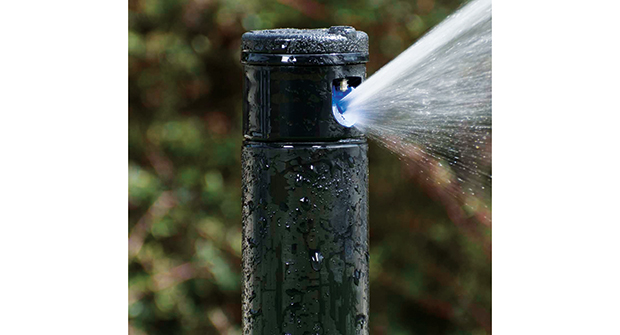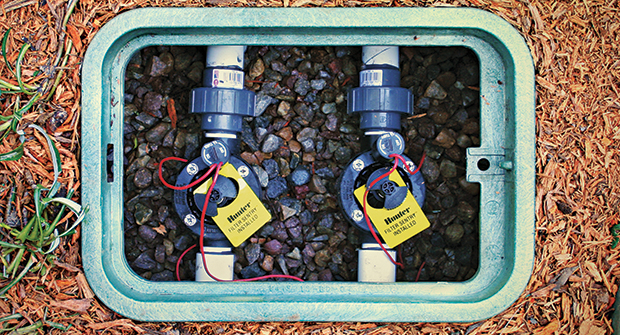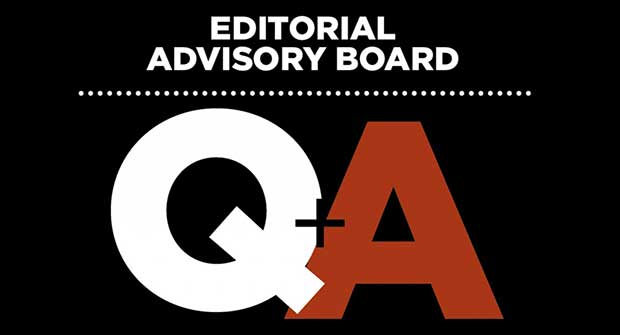Before putting a shovel or trencher in the ground, irrigation contractors need a clear plan that ensures their irrigation systems will be correctly installed.
Proper planning
First on the list is to call 811 to have the utilities flagged on the property. Next, irrigation contractors need to know what they will be digging into.
Understanding the soil type is important because some areas can be rocky and possibly require additional tools or equipment to get the pipe buried to the proper depth. The soil also affects the man-hours required and watering time for the zones to prevent runoff, says Jason Fuller, president of Red & White Greenery in Georgetown, Texas.
The company provides irrigation, landscape, hardscape, site furnishings, masonry and commercial maintenance. Fuller’s customers are 80 percent commercial and 20 percent residential, and the company has an annual revenue of $11 million.

The irrigation plan should detail all aspects of the system, including the type, size and location of the backflow preventer; mainline pipe sizing and general location; valve size and location; lateral line size and general location; and irrigation head type, nozzle size and location.
They should check the flow and pressure at the meter, which will alter the design of the irrigation system, Fuller says. Installers must also consider the contour of the property and the different types of irrigated vegetation.
Visiting the property before installation allows contractors to flag any conflicts between the landscape plan and real-world site, says Steve Barendt, senior contractor account manager, Rain Bird.
“Make adjustments as necessary, being sure not to exceed flow rate available on the zone,” Barendt says. Mark any changes made during installation on the as-built plan.
Start digging
While the depth of the trench will vary based on local codes and geographical locations, there are general guidelines. On a residential property, an acceptable depth for the pipes is 8 to 12 inches, says Steve Hoveln, senior product manager of rotors, valves and accessories at Hunter Industries.
For commercial projects, the mainline tends to be about 18 to 24 inches deep, with the lateral lines from the valve out to the sprinkler heads being installed shallower, around 8 to 12 inches, he adds.

When using gasketed pipes on commercial properties, contractors must consider the higher flow rates, which can cause damage on angles if not handled correctly, Hoveln says. Installers should add a thrust block every time the pipe turns 90 degrees, encasing the entire fitting in concrete or installing blocks behind it as a holder.
Once the valves are set and the pipe is connected, connect swing joints to the rotors and then adjust to the proper height. After adding the nozzles, installers can begin adjusting rotors to the proper arc to avoid overspray on hardscapes or buildings. You can make some of the adjustments before running the zone, Barendt says, but the zone should be running to fine-tune it.
While backfilling may seem straightforward, there’s a proper way to bury lines, says Michael Derewenko, marketing manager, Jain Irrigation.
If the property is rocky and PVC pipe is laid in the trench, the sharp rocks will likely wear on the pipe from the minor vibrations, causing issues, Hoveln says. Creating a sand bed for the pipe to rest on — as well as backfilling with sand — will keep sharp edges from damaging the pipe.
Mistakes to avoid
There are several potential pitfalls when it comes to installing irrigation systems.
Avoid installing sprinklers directly onto rigid PVC because the bases can break when mowers or vehicles run over them. To allow for movement in a sprinkler, premade swing joints should be used — or flexible tubing at lengths of 18 to 24 inches, depending on grade.
Laterals should run parallel, not on top of each other when possible, as recently filled ditches don’t have the strength that compacted dirt offers. If heavy machinery drives over newly buried lines, pipes can crush each other, causing hard-to-see hairline breaks. Contractors should also be sure not to leave trash and debris in ditches, Derewenko says.
“The big one is leaving trash and debris in ditches. Not only is this adding garbage to a site, but rocks can pierce pipes after lines are installed,” Derewenko says. “Along with keeping debris out of ditches, it’s always good to walk the newly added soft dirt to make sure lines are compacted and sprinklers are installed to grade and pointed in the right direction.”
Improper nozzle selection is another common mistake, Barendt says. For example, contractors may install a No. 2 or No. 3 nozzle on every rotor in a zone. Since all rotors will emit the same amount of water and rotate at the same speed, a 90-degree rotor will get twice the amount of water as a 180-degree rotor because it covers the arc twice in the time it takes the 180-degree one to cover once.
“This also means that if there are any 360-degree rotors in the middle of the yard, it will only cover the arc once — while the 90-degree rotors in the corners cover four times,” Barendt says. “The result is soggy corners that are being overwatered and/or center areas that are dry and underwatered.”
The solution for this issue is to size the nozzles and space according to the manufacturer’s guides. Changing nozzle sizes will also alter the distance it throws, so space and size them for proper head-to-head coverage with the correct size nozzle, Barendt adds.
By using quality craftsmanship and products, installers can ensure the system will last decades and bring savings to customers.
Fuller adds, “One of the main benefits of a properly designed and installed irrigation system is that a client is able to irrigate their property effectively and efficiently, saving them time, and most importantly, money.”

